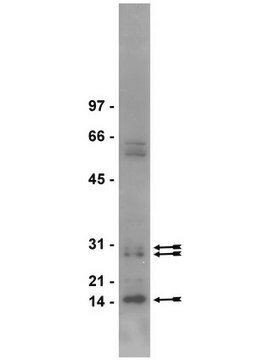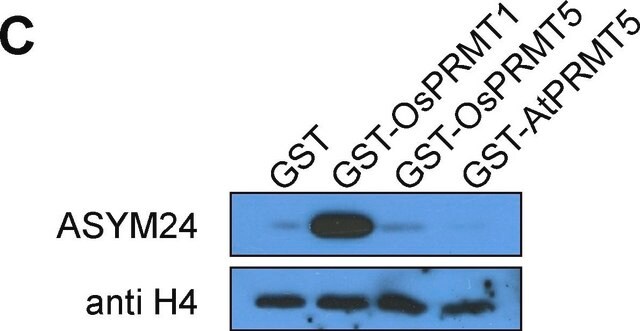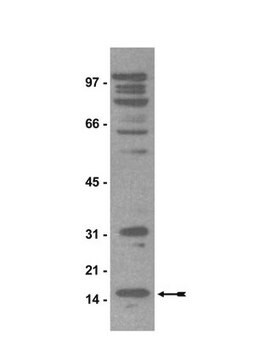09-814
Anti-dimethyl-Arginine Antibody, asymmetric (ASYM25)
serum, from rabbit
Synonym(s):
dimethyl-arginine, asymmetric
Sign Into View Organizational & Contract Pricing
All Photos(1)
About This Item
UNSPSC Code:
12352203
eCl@ss:
32160702
NACRES:
NA.41
Recommended Products
biological source
rabbit
Quality Level
antibody form
serum
antibody product type
primary antibodies
clone
polyclonal
species reactivity
mouse
species reactivity (predicted by homology)
rat (based on 100% sequence homology), human (based on 100% sequence homology)
technique(s)
western blot: suitable
shipped in
wet ice
target post-translational modification
unmodified
General description
Asymmetrical dimethlarginine (ADMA) is an endogenous, L-arginine metabolite arising from the proteolysis of methylated arginine containing proteins and is a known inhibitor of nitric oxide synthase (NOS). In various studies, ADMA has been observed as having a regulatory role in cell motility and the actin cytoskeleton. Elevated levels of ADMA are associated with sporadic FSGS, coronary artery disease, hypertension, peripheral arterial occlusive disease, obesity, stroke, preeclampsia, and cardiovascular mortality/morbidity in patients with diabetic nephropathy.
Specificity
This antibody recognizes dimethylated arginines.
Immunogen
KLH-conjugated linear peptide containing asymmetric dimethyl-arginine-glycine repeats.
Application
Detect dimethyl-Arginine using this Anti-dimethyl-Arginine Antibody, asymmetric (ASYM25) validated for use in WB.
Quality
Evaluated by Western Blot in PRMT1 treated and untreated MEF cell lysates.
Western Blot Analysis: 1:1,000 dilution of this antibody detected dimethyl-Arginine on 10 µg of PRMT1 treated and untreated MEF cell lysates.
Western Blot Analysis: 1:1,000 dilution of this antibody detected dimethyl-Arginine on 10 µg of PRMT1 treated and untreated MEF cell lysates.
Target description
Multiple. This antibody detects proteins containing asymmetrical dimethylated arginines.
Analysis Note
Control
PRMT1 treated and untreated MEF cell lysates
PRMT1 treated and untreated MEF cell lysates
Not finding the right product?
Try our Product Selector Tool.
Storage Class
10 - Combustible liquids
wgk_germany
WGK 1
Certificates of Analysis (COA)
Search for Certificates of Analysis (COA) by entering the products Lot/Batch Number. Lot and Batch Numbers can be found on a product’s label following the words ‘Lot’ or ‘Batch’.
Already Own This Product?
Find documentation for the products that you have recently purchased in the Document Library.
Li-Ming Liu et al.
Cancer research, 79(11), 2865-2877 (2019-04-25)
C/EBPα is an essential transcription factor involved in regulating the expression or function of certain cell-cycle regulators, including in breast cancer cells. Although protein arginine methyltransferases have been shown to play oncogenic roles in a variety of cancers, little is
Yongtai Bai et al.
Molecular cell, 75(6), 1299-1314 (2019-07-30)
MRE11 nuclease forms a trimeric complex (MRN) with RAD50 and NBS1 and plays a central role in preventing genomic instability. When DNA double-strand breaks (DSBs) occur, MRN is quickly recruited to the damage site and initiates DNA end resection; accordingly
Minghao Yang et al.
Cell death & disease, 13(9), 815-815 (2022-09-24)
Osteosarcoma (OS), the most common primary malignancy of the bone, has a poor prognosis due to its high mortality rate and high potential for metastasis. Thus, it is urgently necessary to explore functional molecular targets of therapeutic strategies for osteosarcoma.
Li-Ming Liu et al.
Life (Basel, Switzerland), 11(8) (2021-08-28)
The protein p53 is one of the most important tumor suppressors, responding to a variety of stress signals. Mutations in p53 occur in about half of human cancer cases, and dysregulation of the p53 function by epigenetic modifiers and modifications
Zhen-Yu Zuo et al.
Nucleic acids research, 50(4), 2005-2018 (2022-02-10)
The second cell fate decision in the early stage of mammalian embryonic development is pivotal; however, the underlying molecular mechanism is largely unexplored. Here, we report that Prmt1 acts as an important regulator in primitive endoderm (PrE) formation. First, Prmt1
Our team of scientists has experience in all areas of research including Life Science, Material Science, Chemical Synthesis, Chromatography, Analytical and many others.
Contact Technical Service








